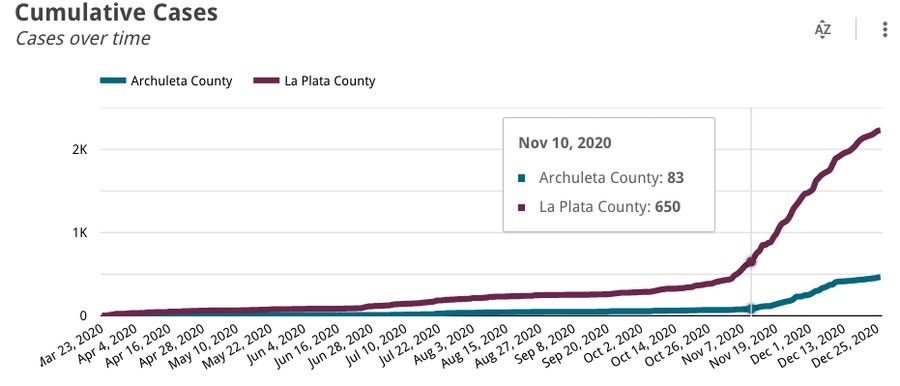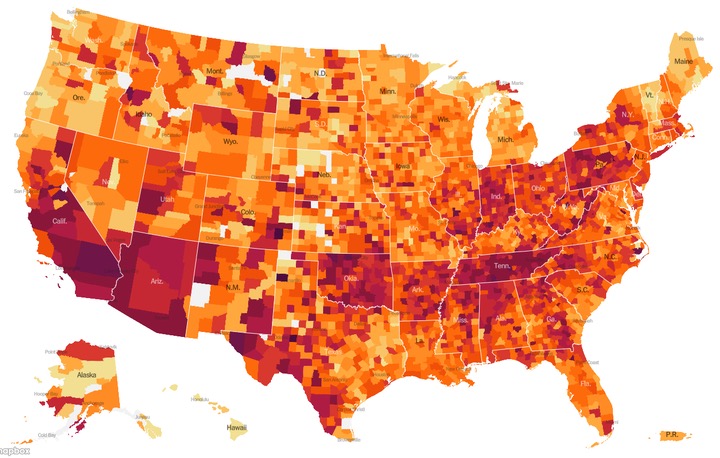Turns out Thanksgiving wasn’t so dangerous after all.

The confirmed cases of SARS-CoV-2 infections have continued to mount in Archuleta County and in La Plata County going into the Christmas season, but perhaps at a slower pace than what we’d expected. And last week, local public health agencies and healthcare facilities in southwest Colorado began to receive their first shipments of the Moderna COVID-19 vaccine. From a press release sent out by San Juan Basin Public Health:
The Moderna COVID-19 vaccine doses will be allocated to Phase 1A healthcare workers according to the state’s COVID-19 vaccine plan. Facilities receiving the vaccine began administering the vaccinations to their frontline staff.
Individuals in phase 1A include high-risk health care workers who have direct contact with COVID-19 patients, and long-term care facility staff and residents. Once distribution to all individuals in Phase 1A is complete — as more vaccine becomes available — distribution to phases 1B, 2, and 3 will follow subsequently. The Moderna vaccine received thus far will not be enough to vaccinate all individuals in the Phase 1A category.
It is expected that the initial supply of COVID-19 vaccine(s) will be very limited for several months. This means that a vaccine will not be immediately available to everyone who wants one. The phased approach to vaccine distribution was developed to be as equitable and efficient with distribution as possible, with the goal of saving lives by vaccinating people who are most likely to get COVID-19 first.
“We are extremely pleased with how well the initial distribution of Pfizer COVID-19 vaccine went last week, with Southwest Colorado achieving 100% on-time distribution and administration of its allotment of vaccine,” said Liane Jollon, executive director of San Juan Basin Public Health.
Things hadn’t sounded quite so hopeful during November, when confirmed infections were spiking in both La Plata County and Archuleta County. Here’s how the cumulative rate of local infections looked on November 10, when the confirmed cases were just beginning to spike in both counties. (The vertical gray line indicates November 10):
From March 23 through November 10, Archuleta County had seen a total of 83 confirmed cases. (I use the term “confirmed cases” because I believe, based on various news reports, that a certain number of people infected with the coronavirus never get confirmed, either because their symptoms are too mild to cause concern, or because they don’t trust the American healthcare industry, or the test gives inaccurate results.)
La Plata County, with a population four times the size of Archuleta County, stood at 650 cases on November 10.
Confirmed cases began to spike in both counties, and by December 10, La Plata had logged 1,886 cases (nearly triple the November 10 count) and Archuleta County was at 403 (nearly five times the November 10 count).
If that same November infection rate had continued on past December 10, Archuleta County would have seen about 575 confirmed cases by the Christmas weekend. And some of us suspected it might do exactly that, due to Thanksgiving weekend gatherings. But in fact, the rate of increase dropped off. On the day after Christmas, December 26, Archuleta County’s official count stood at 464. Still not great, but better than 575.
La Plata County also saw its spike slow somewhat after December 10, hitting an official total of 2,230. If the November rate had continued, we might have seen more like 2,550 confirmed infections by December 26. Apparently, whatever happened in southwest Colorado over the Thanksgiving weekend didn’t produce the threatened spike in new cases. For more information on our local COVID-19 situation, see: https://sjbpublichealth.org/covid-19-vaccine/
The situation across the rest of the US, following the Thanksgiving holiday, was a mixed bag, with some places showing a tapering off of new cases going into December, and some places still spiking. Here is a map produced by The New York Times over the past weekend, with the darkest red color indicating more than 2 new cases per 1,000 population, over the past seven days. Especially hard hit, it would appear, are southern California, Arizona, the Navajo Reservation in New Mexico, southwestern Texas, Oklahoma, and Tennessee.
Globally, other countries seeing new spikes in December include the UK (with evidence of a new, possibly more contagious strain of the SARS-CoV-2 virus) Czech Republic, The Netherlands, Denmark, Portugal, and Israel. But no country has yet come close to the total number of deaths seen in the US. With only about 4 percent of the world’s population, the US has thus far suffered about 19 percent of the global death toll.
Over the weekend, Colorado Senate President Leroy Garcia, a practicing paramedic, was among the state’s healthcare workers who received the first round of innoculations.
“Working on the frontline during this pandemic has been extremely eye-opening. I continually feel humbled by my colleagues’ sacrifice, resiliency, and commitment. Shift after shift, surge after surge these brave men and women put their own health and safety at risk — submerged by the brutality of this illness every day. But with the new vaccine finally being distributed, we can finally rest assured that this harrowing time is almost over.”
“Almost over” might be exaggerating the situation, however. It’s one thing to assume that 70 percent of Americans will sign up to receive the vaccine, so that ‘herd immunity’ can be created. (And assuming it’s available for free, or at a low cost.) From what I’ve read, that will probably not occur until summer, 2021.
It’s another thing to assume the vaccine protection is long lasting, rather than temporary. (We don’t yet know if that’s the case.)
It’s yet another thing to assume that mutant strains will not develop and spread — and if they do, that the existing vaccines will still provide protection.
And if those things happen… if 70 percent of Americans get the shot by next summer, and the vaccines prove effective…
How long will it then take to get the US economy back on its feet?




